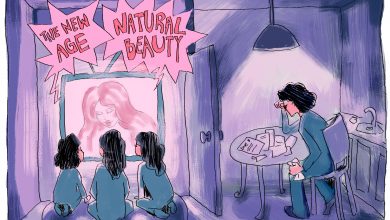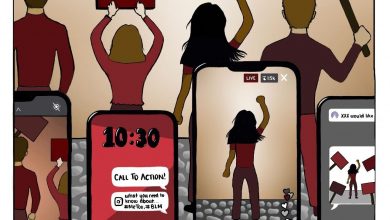Gender Beyond LGBTQ+ Labels
Our understanding of gender and sexuality is constantly changing. With the advancement of LGBTQ+ support, labels like transgender and nonbinary have helped people understand the fluidity of gender. The LGBTQ+ movement is noted for its inclusion, but has an exclusionary history towards people of color. Although Black and Brown people have been revolutionaries of the LGBTQ+ movement, people of color still struggle to feel seen within the community.
The modern LGBTQ+ movement often fails to address communities of color when discussing topics such as gender. While terms like ‘nonbinary’ and ‘transgender’ are used commonly in English, gender-related terminology from other countries are less likely to be recognized. Communities of color including South Asian Hijras, Indigenous Two-Spirits and Indonesian Bugis people have held their own gender taxonomy for centuries. However, these identities and expressions are often left unacknowledged in LGBTQ+ discourse or are exoticized and exemplified as ‘third genders’ without true understanding of their nuances.
The gender binary emerged in the Enlightenment period in order for men to hold power over women; as a result, the vast array of cross-cultural genders are not captured in Euro-American classification. Gender categorization is not historically nor geographically universal.
Gender labels outside the binary have been typically coined by Euro-Americans and address their specific country’s genders. For instance, nonbinary was first used in the book “Unseen Genders: Beyond the Binaries,” which was written by two Australian scholars. Transgender, an umbrella term used to define an individual with a different gender identity than assigned at birth, was first used by American trans activist and writer Virginia Prince in the 20th century.
Trans people did not recently come into existence even though the term was defined less than a century ago. Many ancient cultures depicted trans people in their writing and art. This includes Indian literature, historical evidence of Mesopotamian and Babylonian “Gala” priest-priestesses and the indication of a third gender at the Iranian (Persian) Hasanalu site. Although there has been historical evidence of trans people existing spanning across centuries, our gender categorization has failed to acknowledge their existence until recently.
Outside Euro-American societies, gender identities and expressions exist that do not fall under modern labels. In “Feminism 101: What is the Gender Binary?,” Elena Torres-Pepito writes that “Many (non Euro-American) societies allow people to possess traits that align with both sides of our binary at once, or to adopt traits corresponding with what we may see as the opposite gender.” Individuals with these identities are often called transgender or nonbinary even if they do not identify as either.
For example, the South Asian Hijra community considers themselves neither male nor female. Although many Hijras are transgender, nonbinary, and intersex, the community does not typically use these labels. Some Hijras are trans, but not every Hijra transitions to a gender other than the one assigned at birth. Hijras are mislabeled as transgender when community members have indicated that the community as a whole does not identify with the term.
Hijras are also widely regarded as a third gender. If you look up “Hijra” online, “third gender” is what likely accompanies it. The term “third gender” in relation to Hijras has been contested.
In “The Sex Binary is not a ‘Western Construct,’ Gender Identity Is,” South Indian feminist L. Beatrice states that the Hijra community includes “eunuchs, transvestites, people with ambiguous genitalia and sexually “ambivalent” men who dress up as women.” She further claims that labeling Hijras as a third gender is harmful because the community is so diverse. L. Beatrice argues that the open interpretation of “third gender” can affect children born intersex or with ambiguous genitalia; they are automatically assumed to be a third gender.
When Hijras are falsely identified as transgender (or arguably as a third gender), oftentimes without context, the complexity of their identities is forgotten. Hijras have been frequently cited in ancient Hindu mythology and religious stories. They are thought to be “God’s chosen people” and have special powers. The religious and spiritual history of Hijras is lost when they are reduced to labels that do not properly define them.
Many Hijras even take issue with the transgender movement and have expressed they do not want to be called transgender.
The conflation of ‘transgender’ with other cross-cultural genders is not unique to South Asian Hijras. In Indonesia, the Bugis people of South Sulawesi recognize five genders: makkunrai (cis female), oroani (cis male), calalai (assigned female at birth but enact male gender roles), calabai (assigned male at birth but enact female gender roles), and bissu (neither male or female, representative of the entire gender spectrum).
The calabai do not impersonate women. Instead, they enact a unique set of behaviors stereotyped as feminine. Some examples include wearing miniskirts, smoking and acting in an “outwardly sexualized manner.” If makkunrai (cis women) acted the same, they would face scrutiny from their community. Similarly, the calalai are generally assigned female at birth but adopt male gender roles such as doing manual labor, smoking cigarettes, donning their hair short and wearing trousers and shirts.
The bissu are neither male or female. They personify the totality of the gender spectrum. Bissu are seen as spiritual people with both male and female powers; they are intermediaries between humans and the gods and many of them are priests. Many bissu are born intersex, but this is not always the case.
The calai, calabi and bissu are often misgendered. If you search ‘gender in Bugis society’, the top Wikipedia article calls calalai ‘transgender men’ and calabai ‘transgender women.’ It then indicates that the bissu are loosely comparable to intersex individuals. Not all calabai or calalai identify as transgender since behavioral changes are what signifies their gender. Defining bissu as intersex individuals disregards the spiritual aspect of being bissu while erasing bissu people who are not intersex. Not all bissu people have intersex genitalia, and the Wikipedia definition does not include the central idea that bissu reflect the entire gender spectrum and are neither male or female.
In the United States, gender identities outside of the sex binary existed before colonialism. The Indigenous Two Spirit community, which existed before colonialism, consists of individuals that identify as having both a male and female spirit. This term is used to describe someone’s sexual, gender and spiritual identity. Two Spirit has been used to distance Indigenous gender roles from standard LGBTQ+ labels. This removal is likely to prevent the conflation of being Two Spirit and identifying as trans or nonbinary. Two Spirit folks have their own identity and expression that exists outside of LGBTQ+ lexicon; this identity has existed long before modern labels were invented.
The use of “spirit” was aimed to emphasize that it is one’s spirit, not their body, that is most central to personhood. “Two Spirit” emerged in the 1990s as a pan-Indigenous term. It was created in resistance to the French slur ‘berdache’ so that Indigenous people would be able to define themselves. There are other tribe-specific “third gender” and non-binary categories. Two Spirit does not encompass all Indigenous genders.
When analyzing gender in collectivist cultures, one’s community can play a significant role in gender expression and identification. Indigenous coming of age rituals are special rites of passage where one acquires gender roles and uses community resources to understand their gender. Elders sometimes acknowledge and affirm someone’s gender through specific rituals and ceremonial roles. Many of these rituals have become gender inclusive and age ritual camps are now tailored for LGBTQ+, genderfluid and Two Spirit youth.
This factor is often neglected in non-collectivist cultures’ ideas about gender. This is not to argue that one’s gender identity should be determined by other people, rather, I provide this information to show that modern LGBTQ+ discourse fails to address how community processes can play a role in a community member’s gender identity.
Gender labels can offer a way for people to understand themselves and feel comfortable, but they should not be forced upon others. While ‘transgender’ is used mainly as a form of self-identification, it has also served as a way to incorrectly label others.
It can also be harmful to label communities with different gender norms as communities with different gender identities. Sometimes, it is a change in gender presentations, sexual activities and body modifications instead of a change in gender identity. For instance, American activists often see Two Spirit people as having another gender identity. Being Two Spirit can have different meanings across tribes, and it can be a shift in gender roles as opposed to a shift in gender identity.
There is no one true way to conceptualize gender. When Euro-American terminology is used as a universal classification of gender, the nuance of cross-cultural gender and sexuality is lost. While the communities mentioned in this article might challenge your notions of gender, we must refrain from mislabelling and forcefully adapting them to our cultural standards. Societal conceptions of gender must be challenged in order to properly understand gender across cultures.




